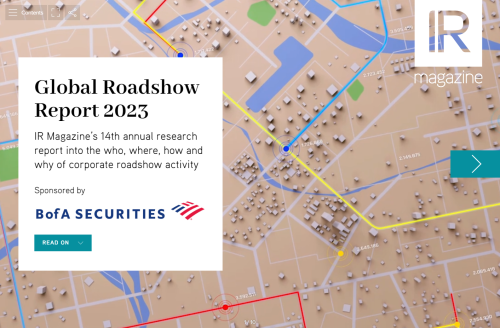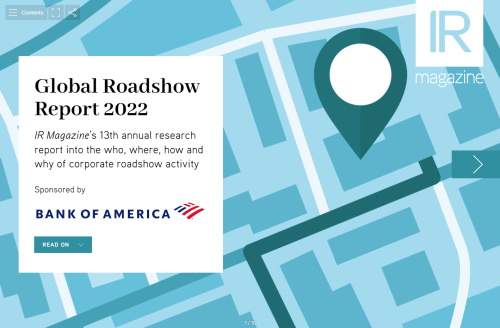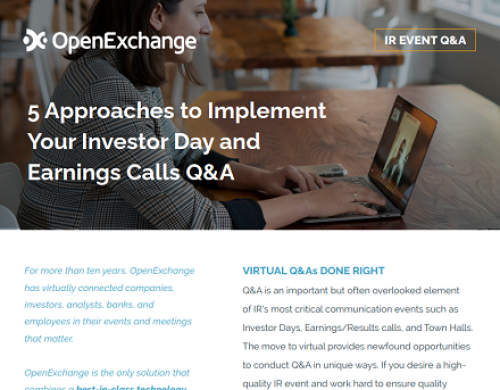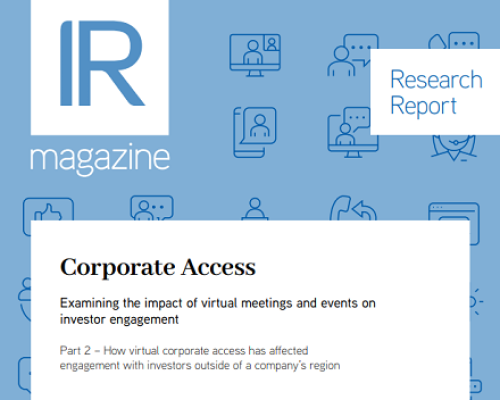Social media-based live streaming, virtual reality (VR) and augmented reality (AR) have the potential to enhance a range of investor relations tasks in the near future, including earnings calls, corporate access, marketing and roadshows. IR Magazine takes a look at the potential uses for these innovations, draws comparisons to how they are being used in other contexts and assesses how far away they may be from being a staple in an IR toolkit.
Live streaming earnings on social media
After T-Mobile went public in 2013, the company’s management wanted to stand out from their competitors. Based on feedback from investors and analysts, in 2014 the company took a new approach to its earnings call by scrapping the slideshow and limiting prepared remarks to a minimum to provide more time for free-flowing dialogue with analysts, investors, media and consumers. It also went one step further and started offering a ‘behind the scenes’ live stream of the earnings call on YouTube (see embedded video below).
For T-Mobile, earnings calls are an opportunity to emphasize that its brand is open and transparent - complete with the company’s entire executive team (all wearing magenta T-Mobile shirts), vintage microphones and at least one magenta cowboy hat (worn by the CFO Braxton Carter).
‘We work very closely with our media team around earnings and they see this as an opportunity to reach a broader audience. Our earnings calls tend to be very visual,’ Nils Paellmann, vice president and head of IR at T-Mobile tells IR Magazine.
The company averages 10,000 to 20,000 views per video, with its most viewed earnings call receiving more than 50,000 hits. The executive team takes questions via the traditional conference call, by text, by Facebook and by Twitter, creating the atmosphere of a radio phone-in.
Netflix also streams its earnings calls live through Google Hangouts and YouTube. Whereas T-Mobile has largely stuck to the same formula since 2014, Netflix has changed its style and approach several times, most recently scaling the video stream back to a series of talking heads. But is this any more beneficial than uploading the earnings call and holding slides to the company website or to YouTube?
‘It comes down to marketing,’ says Q4 CEO Darrell Heaps. ‘What you’re looking at is the companies that would benefit from using these tactics as part of their brand and communicating how they want to be with the market. If you’re a business that is primarily institutionally held and you’re not really connected to anything social media- or technology-related, it’s probably not going to be core to your brand.’
Indeed, one look at how T-Mobile CEO John Legere uses social media – he recently hosted an hour-long phone-in with T-Mobile customers to celebrate his 100th Periscope video, for example – will tell you that the company is probably an outlier in its progressive use of social media.
Virtual reality for investor site visits
As wearable VR technology has become more popular and affordable for consumers, there are more ways it can be applied outside of video games and immersive cinema. Perhaps the most pertinent example for investor relations professionals is to look at how non-profits are using the technology to transport viewers to new locations and give them a feet-on-the-ground sensation.
The Clinton Foundation was an early adopter, creating a VR experience in 2015 that took viewers on a trip to East Africa with Bill and Chelsea Clinton. Since then, it has been adopted by a variety of non-profits, including Alzheimer’s Research UK, Amnesty International UK and Pencils for Promise – which raised $2mn at one fundraiser when it launched its VR video.
While non-profits are using VR as a so-called ‘empathy machine,’ it could be seen as a powerful, low-cost alternative to transporting investors, analysts or senior executives to corporate sites around the world. Last year, the industrial company Hydro Quebec launched a VR video to this effect (video embedded below), giving viewers a guided tour of a hydro-electric dam and placing them in areas that would be too dangerous or difficult to get to ordinarily.
Teck Resources developed a similar VR video, which it used in April with its board directors and senior executives to demonstrate improvements to productivity and safety standards at one of its remote sites in British Columbia. ‘Anecdotally, our leadership is really excited about the potential of the technology and how we can use it with different stakeholders, from investors to employees,’ Doug Brown, director of public relations at Teck Resources, tells IR Magazine.
VR has been labelled as expensive and time-consuming by some critics, but Brown says the video took and a day and a half of filming and then a few weeks of editing. Teck Resources intends to develop more VR videos to explore how the technology could be used elsewhere, and while the company is interesting in exploring how it could potentially be used to engage investors, board members and senior management, Brown is clear that it sits alongside in-person visits, rather than replacing them.
‘VR doesn’t replace site visits because you get to talk to people on the ground,’ he says. ‘VR is a new tool that can be especially useful when putting directors in places that they wouldn’t normally be able to go – like behind the wheel of heavy equipment or giving them an aerial view of a site.’
Augmented reality for roadshows
If VR can give an immersive experience from the relative ease and comfort of an office building, AR presents the opportunity to display real-time data through wearable technology.
This notion was popularized by Google Glass, which may have struggled to find social acceptance with consumers but is now carving out a market as an enterprise tool. For instance, GE’s mechanics and engineers have seen an 8 percent to 12 percent productivity boost by using the technology. Competitive AR tools are also being developed by Apple, Microsoft, Intel and Lenovo.
This technology could be extremely useful for investor relations teams during a roadshow, Heaps says. ‘An interesting use case which hasn’t happened yet would be when you can map intelligence data when you go on a roadshow. If you can meet with a portfolio manager and see real-time what they’re investing, what the fund is really doing and what that means to you as a company, that’s very powerful.’
But Heaps says it could be some time until such technology becomes socially acceptable in this context. ‘In IR, we’re a lagging adopter of these technologies and it’s going to take time for general social adoption,’ he says.
With the business world waking up the opportunities of AR, however, industry could be on the precipice of an explosion of use cases, according to projections from International Data Corporation (IDC), which tracks trends in AR and VR headset usage. In 2016 there were just over 162,000 AR headsets shipped worldwide. By 2021, IDC estimates that 24.5 million headsets will be shipped and that 83 percent of those will be used in a commercial context.
‘It is very clear to us that augmented reality is the larger of the two plays here when looking at AR and VR combined,’ says Ryan Reith, program vice president with IDC's Worldwide Quarterly Mobile Device Trackers in a company press release. ‘Companies like Microsoft, Epson, Intel, Meta, ODG and DAQRI are already providing devices that are being deployed in real-time commercial projects with significant ROI.’










